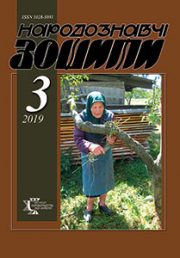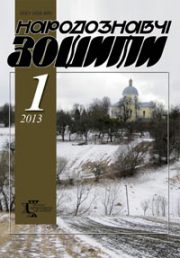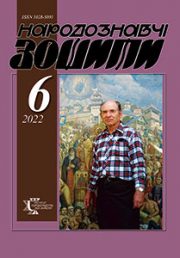The Ethnology Notebooks. 2023. № 1 (169), 95—119
UDK [39:911.373:643.53:645.48-053.2/.6](477:292.452=161.2)”19/20″
DOI https://doi.org/10.15407/nz2023.01.095
SYVAK Vasyl
- ORCID ID: https:/ /orcid.org/0000-0002-6444-0705
- Candidate of Sciences in History, Researcher,
- Institute of Ethnology of the National Academy of Sciences of Ukraine,
- Department of Historical Ethnology,
- Prospekt Svobody, 15, 79000, Lviv, Ukraine,
- Contacts: e-mail: suvakvasul@gmail.com
Abstract. Furniture intended for sleep and rest for children took an important role in the daily life of Ukrainian`s of Carpathians at the end of the 19th — the first half of the 20th century. These included cradles, cradles-cribs, and cribs of various materials, sizes, shapes, structural details, connections, and decorative solutions, which were made at home for children of different age categories — from one to four years. This gives us a reason to separate them into a corresponding component in the structure of the study of folk furniture of Ukrainian Highlanders in general. They functioned in public housing in all ethnic lands of Ukraine, countries of Europe, Asia and the Caucasus. To date, there are no general works on the problem indicated for research, in which these products would be reflected.
The relevant matter of investigation for Ukrainian ethnological science to this day is study of handmade, or with the help of appropriate means at home, products dedicated for children, which functioned in the peasant housing of the Carpathian Ukrainians in the late XIXth — the first half of the XXth centuries, the basis of which were cradles, cradles-cribs and cribs, which was also characteristic for other ethnographic regions and districts of Ukraine (according to the current zoning). The purpose of the research is to collect, analyze, systematize available sources, archival, museum and published materials of researchers of different periods on the researched topic. The object of the study is products for appropriate age category children’s` sleep or rest, and the subject is a variety of materials from which tools, technical and constructive options were made. The general scientific principles of historicism, systematicity, and scientific objectivity became the methodological basis of the research, which made it possible to carry out the necessary scientific analysis of the researched topic in general, as well as its individual aspects. To date, the specified problem has not been a separate object of research. The territory of the study covers three ethnographic regions of the Ukrainian Carpathians Boikivshchyna, Hutsulshchyna and Lemkivshchyna. The chronological limits of the study cover the end of the 19th the first half of the 20th century. The source base was formed with the help of stationary and route ethnographic expeditions, during which the recording of field materials was carried out by means of photography, measurements, sketching of relevant objects, oral interviews of respondents, therefore a significant part of the work is the author’s field materials.
Keywords: Ukrainian Carpathians, Boikos, Hutsuls, Lemkos, cradles, cradle-cribs, cots, devices, products, means, methods.
Received 15.02.2023
REFERENCES
- Sopolyha, M. (2016). Folk architecture of Ukrainians in Slovakia [in Ukrainian].
- Syvak, V., Sopolyha, M. (1999). Interior of a dwelling. Traditional furniture. Lemkivshchyna Historical and ethnographic studies: in 2 vol. (Pp. 278—293) [in Ukrainian].
- Beskyd, Yu. (1972). Material culture of Lemkivshchyna [in Ukrainian].
- Boichenko, V. (2003). Brief ethnographic information about the village. Shelves of the Kamin-Kashirskyi district of the Volyn region of the late 19th and early 20th centuries. Ethnocultural heritage of RivnePolissia (Vol. IV, pp. 64—98) [in Ukrainian].
- Svyryda, R.O. (1979). Equipment of traditional housing of the Right Bank Polissia. Folk Ary and Ethnology, 3, 56—63 [in Ukrainian].
- Kosmina, T. (1980). Rural housing in Podillia at the end of the 19th—20th centuries [in Ukrainian].
- Chekhovych, S. (2016). Housing equipment in the western regions of the Ukrainian SSR. Folk Art and Ethnology, 3, 75—84 [in Ukrainian].
- Kaindl, F. (2000). Hutsuls: their life, customs and folk tales [in Ukrainian].
- Shukhevych, V. (2018). Hutsulshchyna: in 5 parts [in Uk rainian].
- Budzan, A. (1979). Folk art crafts of Boikivshchyna. Collection of scientific papers (Pp. 120—123) [in Ukrainian].
- Kishchuk, T. (1987). Interior. Folk architecture of the Ukrainian Carpathians (Pp. 110—126) [in Ukrainian].
- Stankevych, M. (2002). Ukrainian wood for art crafts of the 16th—20th centuries [in Ukrainian].
- Koltativ, S. (1994). Culture of the people of Vilkhovets. Household items in the village. Vilkhovets above the Dniester. Chronicle of Borshchivshchyna: historical and local history collection (Vol. 5, pp. 45—54) [in Ukrainian].
- Moszynski, K. (1929). Slavic Folk Culture (Part I: Material Culture) [in Polish].
- Radovych, R. (2017). Polissia housing: cultural and genetic origins and evolutionary processes [in Ukrainian].
- Hoshko, Yu. (1976). Population of the Ukrainian Carpathians of the XV—XVIII centuries [in Ukrainian].
- Kobilnyk, V. (1936). Material culture of the village of Zhukotyn, Turchansky district. Chronicle of Boikivshchyna (Part 8, pp. 15—71) [in Ukrainian].
- Archive of the Institute of Ethnology of National academy of sciences of Ukraine (IN NASU). F. 1. Op. 2. Unit coll. 402. Ethnographic field materials on the topic «Interior of folk dwellings», collected by V.P. Syvak in Skole and Turka districts of the Lviv region. and Volovets, Mizhhiria districts of the Zakarpattia region in 1994 [in Ukrainian].
- Archive of IN NASU. F. 1. Op. 2. Unit coll. 367. P. 2. Ethnographic field materials on the topic «Interior of folk dwelling», collected by V.P. Syvak in Perechyn district, Transcarpathian region in 1991[in Ukrainian].
- Kotsan, V. (2018). Memories and information from the Verkhovyna village of Bukovets, Volovets district, Zakarpattia region: a manuscript written and edited in 1960—1968 by M.I. Parlag. Scientific collection of the Transcarpathian Museum of Folk Architecture and Life (Vol. 5, pp. 237—277) [in Ukrainian].
- Falkowski, J., & Pasznycki, B. (1935). On the Lemko-Bojkowski border [in Polish].
- Archive of IN NASU. F. 1. Op. 2. Unit coll. 367. P. 1. Ethnographic field materials on the topic «Interior of folk dwelling», collected by V.P. Sivak in Starosambir, Turka districts of Lviv region. and Velykyi Bereznnyi district of Zakarpattia region in 1991 [in Ukrainian].
- Syvak, V. (2003). The interior of a Polissia dwelling. Polissia of Ukraine: materials of historical and ethnographic research (Vol. 3, pp. 125—167) [in Ukrainian].
- Boichenko, V. (2005). Information about the village. Bilovizh, Rokytne district, Rivne region (end of the 19th — beginning of the 20th century). Ethnocultural heritage of Polissia (Vol. VI, pp. 143—188) [in Ukrainian].
- Nikorak, O. (2004). Ukrainian folk fabric of the 19th—20th centuries. Typology, localization, artistic features [in Ukrainian].
- Reinfus, R. (2020). Materials for studying the material culture of the Boikos [in Ukrainian].
- Reinfuss, R. (1977). Folk furniture in Poland [in Polish].
- Archive of IN NASU. F. 1. Op. 2. Unit coll. 359. P. 3. Ethnographic field materials on the topic «Interior of a folk dwelling», collected by V.P. Syvak in the Starosambir district of the Lviv region in 2002 [in Ukrainian].
- Archive of IN NASU. F. 1. Op. 2. Unit coll. 359. P. 4. Ethnographic field materials on the topic «Interior of folk dwelling», collected by V.P. Syvak in Starosambir district of Lviv region in 2007 [in Ukrainian].
- Archive of IN NASU. F. 1. Op. 2. Unit coll. 367. P. 3. Ethnographic field materials on the topic «Interior of folk dwellings», collected by V.P. Syvak in Horodenka, Tysmenytsia and Tlumach districts of Ivano-Frankivsk region, Zastavnivne district of Chernivtsi region in 1997 [in Ukrainian].
- Fedaka, P. (2005). People’s housing of Ukrainians of Transcarpathia in the 18th—20th centuries [in Ukrainian].
- Kozholianko, H. (1999). Ethnography of Bukovyna: in 3 vol. (Vol. 1) [in Ukrainian].
- Archive of IN NASU. F. 1. Op. 2. Unit coll. 426. P. 1. Ethnographic field materials on the topic «Interior of folk dwelling», collected by V.P. Syvak in Zhytomyr and Kyiv regions in 1996 [in Ukrainian].
- Chuhai, R. (1979). Artistic weaving from vines, rushes and straw in the Yavoriv region. Folk art crafts of Ukraine [in Ukrainian].
- Dobrovolska, T. (1994). The interior of the public housing of Slobozhanshchyna. Folk Art and Ethnology, 2, 73—79 [in Ukrainian].
- Archive of IN NASU. F. 1. Op. 2. Unit coll. 364. Ethnographic field materials on the topic «Interior of folk dwellings», collected by V.P. Syvak in the Kosiv and Verkhovyna districts of the Ivano-Frankivsk region in 1990 [in Ukrainian].
- Falkowski, J. (1937). Western borderland of the Hutsul region: the valleys of Prut, Bystryca Nadwornianska, Bystryca Solotwinska and Lomnica[in Polish].
- Falkovski, Ya. (1935). Village of Volosate, Lisky district. Chronicle of Boykivshchyna (Sambir) (Part 5, pp. 14—28) [in Ukrainian].
- Mozdyr, M. (2008). Folk furniture in Ukraine. Genesis. Evolution of forms. The Ethnology Notebooks, 1—2, 160—183 [in Ukrainian].
- Zubrytskyi, M. (1909). Peasant houses in Mshanets, Starosambir district. Materials for Ukrainian-Russian ethnology (Vol. XI,pp. 1—22) [in Ukrainian].
- Archive of IN of NASU. F. 1. Op. 2. Unit coll. 359. P. 1. Ethnographic field materials on the topic «Interior of folk dwellings», collected by V.P. Syvak in Zakarpattia and Lviv regions in 1986 [in Ukrainian].
- Archive of IN NASU. F. 1. Op. 2. Unit coll. 332. Ethnographic field materials on the topic «Interior of folk dwellings», collected by V.P. Syvak in the Ivano-Frankivsk region in 1986 [in Ukrainian].
- Zubrytskyi, M. (1895). The village of Kindrativ, Turka district. Life and word (Vol. 4, pp. 216—230) [in Ukrainian].
- Archive of IN NASU. F. 1. Op. 2. Unit coll. 902. Zosh. 2. Ethnographic field materials on the topic «Interior of folk housing», collected by V.P. Syvak in Turka district of Lviv region in 2019 [in Ukrainian].
- Vovk, Kh. (1995). Studies on Ukrainian ethnography and anthropology [in Ukrainian].
- Lohvyn, H. (1990). Engravings of Ukrainian old prints in the 16th—18th centuries [in Ukrainian].
- Gyozo, S. (1986). Woodcraft. Budapest: Agricultural Publishing House. [in Hungarian].
- Pancuhova, E. (1998). Elements of the folk culture of Slovaks from Madagascar in Svetkov’s finds SNM in Martin. Proceedings of the Slovak National Museum. RXCII, 39: Ethnography (Pp. 107—111) [in Slovenian].







